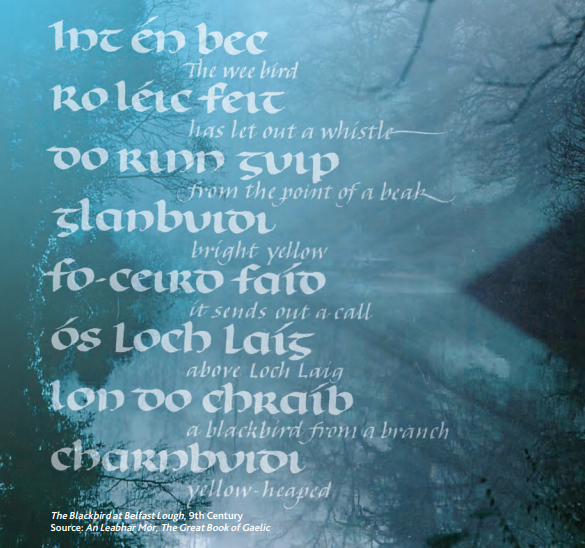My first blog on gorse ( see end of this post) gave rise to some lovely reactions. I went looking for more gorse-related poetry in Irish and Róise Ní Bhaoill, writer, editor and folklorist, gave me such a generous response that her material will supply more than one blog. I am very grateful indeed.
I had referenced the ancient Irish poem commonly known as ‘The Blackbird of Belfast Lough’ so Róise draws our attention to some thoughts from a talk of 2012 by the late Aodán Mac Póilin, formerly Director of the Ultach Trust where he and Róise were colleagues.
“I’d like to give you a taste of the culture of that thousand-year period. I’ll start with a tiny little 9th century poem set on the shores of Belfast Lough, which at that time was called Loch Lao.
Int én bec fo-cheird faíd
ro léic feit ós loch laíg
do rinn guip lon do chraíb
glanbuidi: charnbuidi
This could be translated as:
The small bird which has whistled from the tip of a bright yellow beak sends out a note over Belfast Lough — a blackbird from a yellow-heaped branch.
Or, in John Hewitt’s version (my own favourite):
Across Loch Laig
the yellow-billed blackbird
whistles from the blossomed whin.

“Of poems like this the Celtic scholar Kuno Meyer says:
In nature poetry the Gaelic muse may vie with that of any other nation. Indeed these poems occupy a unique position in the literature of the world. To seek out and watch and love Nature, in its tiniest phenomena as in its grandest, was given to no people so early and so fully as the Celt. … It is characteristic of these poems that in none of them do we get an elaborate or sustained description of any scene or scenery, but rather a succession of pictures and images which the poet, like an impressionist, calls up before us by light and skilful touches. Like the Japanese, the Celts were always quick to take an artistic hint; they avoid the obvious and the commonplace; the half-said thing to them is dearest.
(Meyer, Selections, xii-xiii).
“The verse has three syllables in each line, twenty-four in all, no fewer than fourteen of which play some part in what Eleanor Knott has described as syllabic poetry’s ‘complex mosaic of sound’.”
(Eleanor Knott, Irish Classical Poetry, Dublin, Three Candles Press, 1960, 18-19).
Aodán Mac Póilin’s wonderful book is an essential read for anyone interested in the languages of Ulster.
More Gorse, Whin, Furze to come, including some music , in Blog 3.
Gorse, Whin, Furze – a shared love in Irish, Ulster Scots, Scots & English

